Ijraset Journal For Research in Applied Science and Engineering Technology
- Home / Ijraset
- On This Page
- Abstract
- Introduction
- Conclusion
- References
- Copyright
Study of Composite Light Weight Leaf Spring
Authors: Ramsingar Singh, Dr. H. S. Chandra
DOI Link: https://doi.org/10.22214/ijraset.2024.64073
Certificate: View Certificate
Abstract
The fundamental Objective of this project is to represent plan and exploratory examination of composite leaf spring made of glass fiber reinforced polymer. The intention is to look at the load carrying capacity, weight and stiffness effective of composite leaf spring with that of steel leaf spring. The design imperatives are stresses and deflections. The measurements of a current ordinary steel leaf spring of a light business vehicle are taken. Static investigation of leaf spring is likew ise performed utilizing analysis software and compared with experimental results. Limited component investigation with full load on 3D model of composite multi leaf spring is done utilizing analysis software and the analytical results are compared with experimental result.
Introduction
I. INTRODUCTION
Leaf springs are mainly used in suspension systems to absorb shock loads in automobiles like light motor vehicles, heavy duty trucks and in rail systems. It carries lateral loads, brake torque, driving torque in addition to shock absorbing. The advantage of leaf spring over helical spring is that the ends of the spring may be guided along a definite path as it deflects to act as a structural member in addition to energy absorbing device. According to the studies made a material with maximum strength and minimum modulus of elasticity in the longitudinal direction is the most suitable material for a leaf spring. To meet the need of natural resources conservation, automobile manufacturers are attempting to reduce the weight of vehicles in recent years. Weight reduction can be achieved primarily by the introduction of better material, design optimization and better manufacturing processes. The suspension leaf spring is one of the potential items for weight reduction in automobiles unstrung weight. This achieves the vehicle with more fuel efficiency and improved riding qualities. The introduction of composite materials was made it possible to reduce the weight of leaf spring without any reduction on load carrying capacity and stiffness.
For weight reduction in automobiles as it leads to the reduction of un-sprung weight of automobile. The elements whose weight is not transmitted to the suspension spring are called the un-sprung elements of the automobile. This includes wheel assembly, axles, and part of the weight of suspension spring and shock absorbers. The leaf spring accounts for 10-20% 0f the un-sprung weight. The composite materials made it possible to reduce the weight of machine element without any reduction of the load carrying capacity. Because of composite material’s high elastic strain energy storage capacity and high strength-to-weight ratio compared with those of steel. FRP springs also have excellent fatigue resistance and durability. But the weight reduction of the leaf spring is achieved not only by material replacement but also by design optimization. Weight reduction has been the main focus of automobile manufacturers in the present scenario. The replacement of steel with optimally designed composite leaf spring can provide 92% weight reduction. Moreover the composite leaf spring has lower stresses compared to steel spring. All these will result in fuel saving which will make countries energy independent because fuel saved is fuel produced.
Weight saving but not always are cost-effective over their steel counter parts .The leaf spring should absorb the vertical vibrations and impacts due to road irregularities by means of variations in the spring deflection so that the potential Energy is stored in spring as strain energy and then released slowly. So, increasing the energy storage capability of a leaf spring ensures a more compliant suspension system. According to the studies made a material with maximum strength and minimum modulus of elasticity in the longitudinal direction is the most suitable material for a leaf spring. Fortunately, composites have these characteristics.
Fatigue failure is the predominant mode of in-service failure of many automobile components. This is due to the fact that the automobile components are subjected to variety of fatigue loads like shocks caused due to road irregularities traced by the road wheels, the sudden loads due to the wheel travelling over the bumps etc. The leaf springs are more affected due to fatigue loads, as they are a part of the unstrung mass of the automobile. The fatigue behaviour of Glass Fiber Reinforced Plastic (GFRP) epoxy composite materials has been studied in the past. Theoretical equation for predicting fatigue life is formulated using fatigue modulus and its degrading rate. This relation is simplified by strain failure criterion for practical application. A prediction method for the fatigue strength of composite structures at an arbitrary combination of frequency, stress ratio and temperature has been presented. These studies are limited to mono-leaf springs only.
In the present work, a seven-leaf steel spring used in passenger cars is replaced with a composite multi leaf spring made of glass/epoxy composites. The dimensions and the number of leaves for both steel leaf spring and composite leaf springs are considered to be the same. The primary objective is to compare their load carrying capacity, stiffness and weight savings of composite leaf spring. Finally, fatigue life of steel and composite leaf spring is also predicted using life data.
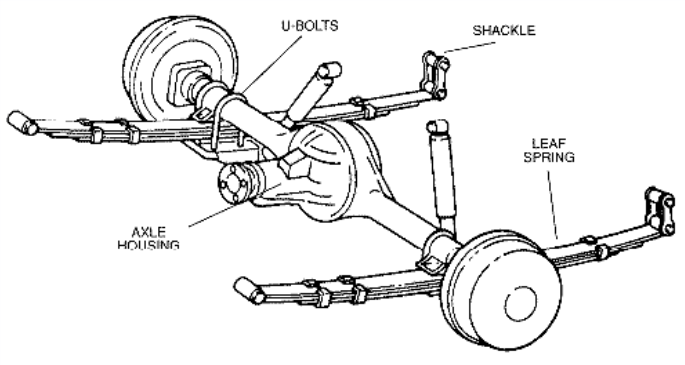
Fig1.1 Traditional rear suspension for front engine
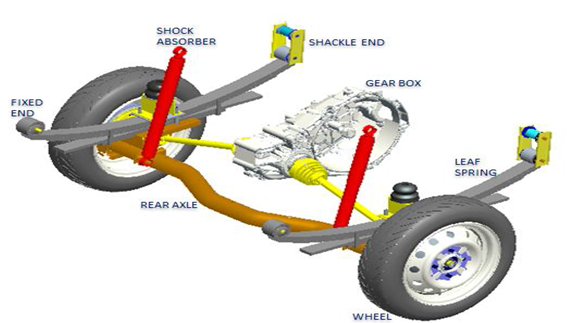
Fig1.2 Non Tranditional rear suspension for rear engine
A. Leaf Spring
In the cantilever beam type leaf spring, for the same leaf thickness, h, leaf of uniform width, b (case 1) and, leaf of width, which is uniformly reducing from b (case 2) is considered. From the basic equations of bending stress and deflection, the maximum stress σmax, and tip deflection max, can be derived.

Figure 1.3:- Design of uniform length
It is observed that instead of uniform width leaf, if a leaf of varying width is used, the bending stress at any cross section is same and equal to maximum stress σmax. This is called as leaf of a uniform strength. Moreover, the tip deflection being more, comparatively, it has greater resilience than its uniform width counterpart. Resilience, as we know, is the capacity to absorb potential energy during deformation.
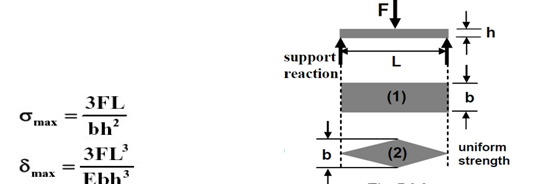
Figure 1.4:- Supporting reaction and uniform strength
One of the applications of leaf spring of simply supported beam type is seen in automobiles, where, the central location of the spring is fixed to the wheel axle. Therefore, the wheel exerts the force F on the spring and support reactions at the two ends of the spring come from the carriage.
II. PAPER REVIEW
Composite materials are now used extensively in place of metal parts. It can find the application of composite materials in several automobile applications. The automobile-sector is showing an increased interest in the area of composite material-leaf springs due to their high strength to weight ratio. Therefore analysis of composite material leaf springs has become essential in showing the comparative results with conventional leaf as High strength, Economy, Versatility & flexibility, Corrosion resistance, Weight advantages of material.
Dara Ashok, et al, In his work they give the information about design and structural analysis of composite leaf spring made of carbon fiber reinforced polymer (GFRP) [1].
Sachin Kr, et al, in the work a general study on the design, analysis and fabrication of composite leaf spring is done. They reviewed some papers on the use of alternate materials, effect of material on leaf spring performance and fatigue life prediction of leaf spring. They focus on the performance of epoxy carbon fiber reinforced materials used in leaf spring [2].
Vinkel Arora, et al, The paper is focused on determination of better eye end design of single leaf spring used in light motor vehicle [3]. The objective of the work is to carry out computer aided design and analysis of a conventional leaf spring, with experimental and computational design considerations and loading conditions using CATIA and ANSYS.
M. M. Patunkar, et al, In his paper a comparison analysis of steel leaf spring is done with a virtual model of a composite leaf spring under the same static load condition. Deflection and stresses of steel leaf spring and composite leaf spring are to be analyzed [4].
M. Raghavedra, et al, The composite material offer opportunities for substantial weight saving but not always are cost-effective over their steel counter parts. From the results, it is observed that the laminated composite leaf spring is lighter and more economical than the conventional steel spring with similar design specifications [5].
M.Venkatesan and D. Helmen Devaraj, The paper gives design and experimental analysis of composite leaf spring made of carbon fiber reinforced polymer. The main objective is to compare the stiffness, load carrying capacity and weight of composite leaf spring with that of steel leaf spring. The dimension of an the light commercial vehicle is used. The design constraints are stresses and deflections. In which finite element analysis with full load on the 3-D model of composite multi leaf spring is done using ANSYS 10 and the analytical results are compared with experimental results. After studying the above paper, it is seen that the study in present topic will find new era in this sector.
A. Specification Of The Problem
The objective of the present work is to design, analyses, Glass Fiber/Epoxy complete composite leaf spring without end joints and composite leaf spring using bonded end joints using hand-lay up technique. This is an alternative, efficient and economical method over wet filament-winding technique.
Leaf springs also known as flat spring are made out of flat plates. Leaf springs are designed two ways: multi-leaf and mono-leaf. The leaf springs may carry loads, brake torque, driving torque, etc. In addition to shocks. The multi-leaf spring is made of several steel plates of different lengths stacked together. During normal operation, the spring compresses to absorb road shock. The leaf springs bend and slide on each other allowing suspension movement.
1) Design Selection
The leaf spring behaves like a simply supported beam and the flexural analysis is done considering it as a simply supported beam. The simply supported beam is subjected to both bending stress and transverse shear stress. Flexural rigidity is an important parameter in the leaf spring design and test out to increase from two ends to the center.
- Constant Thickness, Varying Width Design: In this design the thickness is kept constant over the entire length of the leaf spring while the width varies from a minimum at the two ends to a maximum at the center.
- Constant Width, Varying Thickness Design: In this design the width is kept constant over the entire length of the leaf spring while the thickness varies from a minimum at the two ends to a maximum at the center.
- Constant Cross-Selection Design: In this design both thickness and width are varied throughout the leaf spring such that the cross-section area remains constant along the length of the leaf spring. Out of the above mentioned design concepts. The constant cross-section design method is selected due to the following reasons: Due to its capability for mass production and accommodation of continuous reinforcement of fibers.
Since the cross-section area is constant throughout the leaf spring, same quantity of reinforcement fiber and resin can be fed continuously during manufacture. Also this is quite suitable for filament winding process.
B. Objective
The objective of this project is as follows:
Compare the load carrying capacity, stresses, deflection and weight savings of composite leaf spring with that of steel leaf spring.
The focused on the implementation of composite materials by replacing steel in conventional leaf springs of a suspension system to reduce product weight, improving the safety, comfort and durability.
The 3-D modelling of both steel and composite leaf spring is done and analyzed A comparative study has been made between composite and steel leaf spring with respect to Deflection , strain energy and stresses. From the results, it is observed that the composite leaf spring is lighter and more economical than the conventional steel spring with similar design specifications. It is observed that the weight reduction of mono leaf spring is achieved up 84.94% in case of composite than steel.
The development of a composite leaf spring having constant cross sectional area, where the stress level at any station in the leaf spring is considered constant due to the parabolic type of the thickness of the spring, has proved to be very effective.
C. Methodology/ Planning Of Work
The whole analysis process shall begin with following steps: model definition, meshing, model analysis, validation of the Finite Element Analysis (FEA) model,
The process is briefed stepwise.
- Design of leaf spring: The first step in the process is to define the model geometry. This is done by prepare a 3D solid modelling through using a computer-aided engineering tool, such as Creo.
- Importing solid model data into mesh model: The second step is to import the data from the 3D solid model to the mesh generation software. This is done by creating a mesh model of the solid model after importing all the data into advanced analysis software and mesh generating tool such as ANSYS 14
- Design verification
- Finite Element Analysis(FEA) starts: The finite element analysis was carried out using a commercial finite element analysis software package; ANSYS
- Evaluations of the post processed results: The results are post processed into a form suitable for engineering assessment.
III. FINITE ELEMENT ANALYSIS
FEA tool is the mathematical idealization of real system. Is a computer based method that breaks geometry into element and link a series of equation to each, which are then solved simultaneously to evaluate the behaviour of the entire system. It is useful for problem with complicated geometry, loading, and material properties where exact analytical solution are difficult to obtain. Most often used for structural thermal fluid analysis, but widely applicable for other type of analysis and simulation.
Finite Element analysis tools offer the tremendous advantage of enabling design teams to consider virtually any modelling option without incurring the expense associated with manufacturing and machine time.
The Ability to try new designs or concepts on the computer gives the opportunity to eliminate problems before beginning production. Additionally, designers can quickly and easily determine the sensitivity of specific modelling Parameters on the quality and production of the final part. The leaf spring model is created by modelling software like Creo , Catia, Solid work and it is imported in to the analysis software and the loading, boundary conditions are given to the imported model and result are evaluated by post processor. The different comparative results of steel leaf spring and composite leaf spring are obtained to predict the advantages of composite leaf spring for a vehicle.
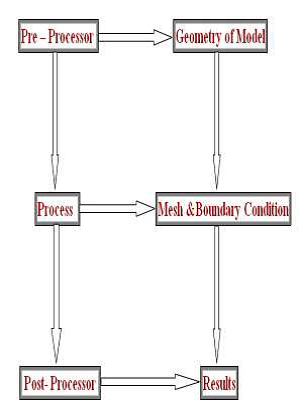
Figure 3.1: TYPICAL FEA PROCEDURES BY COMMERCIAL SOFTWARE
A. Materials for Steel Leaf Spring
Plain carbon steel, Chromium vanadium steel, Chromium- Nickel- Molybdenum steel, Silicon manganese steel, are the typical materials that are used in the design of leaf springs. The material selected for steel leaf spring is 65Si7. The design parameters selected for steel leaf are listed in table 1.
|
Parameters |
Values |
|
Material selected |
Steel 65Si7 |
|
Tensile strength |
1962 N/mm2 |
|
Yield strength |
1470 N/mm2 |
|
Young’s modulus(E) |
2e5 N/mm2 |
|
Design stress(6b) |
600 N/mm2 |
|
Total length |
1540 mm |
|
Arc height at axle seat |
136 mm |
|
Normal static loading |
2500 N |
|
Available space for spring width |
70 mm |
Table3.1: DESIGN PARAMETERS OF STEEL LEAF SPRING
B. Materials For Composite Leaf Spring
Based on the specific strain energy of steel spring and some composite materials, the E-glass/epoxy is selected as the spring material. The parameters for composite leaf spring material are listed in table 2
|
Properties |
Values |
|
Tensile Strength |
900 N/mm2 |
|
Compressive strength |
450 N/mm2 |
|
Poisson ratio (T) |
0.217 |
|
Mass density (ρ) |
2.6e-10 kg/mm3 |
|
Flexural strength( ) |
1200 N/mm2 |
|
Flexural modulus(E) |
40000 N/mm2 |
TABLE3.2: Parameters Of Composite Leaf Spring
IV. MATERIALS FOR STEEL LEAF SPRING
First the material selected for leaf spring is Steel. The design parameters selected for steel leaf are listed in table 1 & 2. The normal static loading is 2500 N and Number of leaves are 7 which is clamped with rectangular clamp.
|
Length X |
1226.1 mm |
|
Length Y |
291.68 mm |
|
Length Z |
111. mm |
|
Space width of leaf spring |
50 mm |
|
Nodes |
2972 |
|
Elements |
527 |
Table 4. 1 Design Details Of Multi Leaf Spring
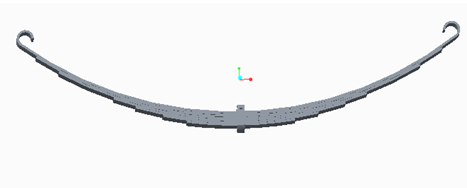
FIGURE 4.1 Design Of Leaf Sring
|
Density |
7.75e-006 kg mm^-3 |
|
Coefficient of Thermal Expansion |
1.7e-005 C^-1 |
|
Specific Heat |
4.8e+005 mJ kg^-1 C^-1 |
|
Thermal Conductivity |
1.51e-002 W mm^-1 C^-1 |
|
Resistivity |
7.7e-004 ohm mm |
Table.4.2 Stainless Steel Constants
A. Materials for Composite Leaf Spring
The biggest benefit, however, is mass reduction: Composite leaf springs are up to five times more durable than a steel spring, A transverse composite leaf spring presses against the lower arm and spans the width of the car. In fact, the spring is always loaded against the sub frame. Composites also have the potential to replace steel and save weight in longitudinal leaf springs.
|
Density |
2.6e-006 kg mm^-3 |
|
Young's Modulus MPa |
85000 |
|
Poisson's Ratio |
0.23 |
|
Bulk Modulus MPa |
524691 |
|
Shear Modulus MPa |
34553 |
|
Tensile Yield Strength MPa |
2050 |
|
Compressive Yield Strength MPa |
5000 |
TABLE. 4.3 E-GLASS/EPOXY MATERIAL
B. Design And Meshing Of Spring
The design of leaf spring is done in creo 3.0
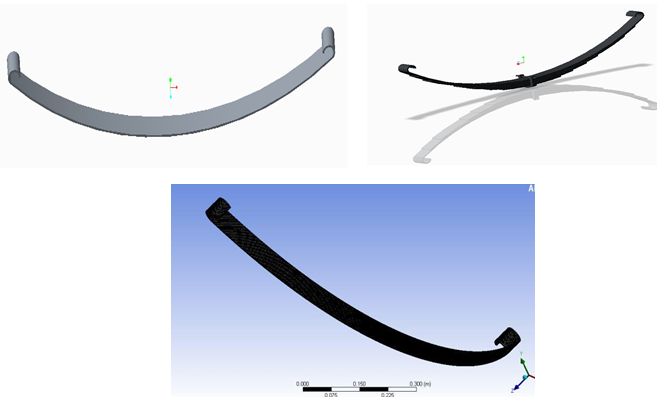
Figure 4.2 Design Of Leaf Spring
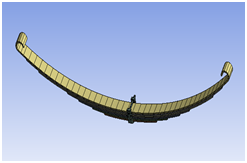
Figure.4.3meshing Of Spring
Mesh generation is the practice of generating a polygonal or polyhedral mesh or we say that it is the discretization of object into the small parts so that to get approximates a geometric domain.
C. Analysis in CREO 3.0
First analysis is done in creo, normal loading acting on spring space is 2500N Material properties is given in table.
|
Density |
1.7072e-05 kg mm^-3 |
|
Young's Modulus MPa |
4.25609e+08 |
|
Poisson's Ratio |
0.3 |
|
Specific heat |
2.22451e+08 mm^2 |
|
Thermal conductivity |
17151.8 mm lbm |
|
Coef. Of thermal Expansion |
9.6e-06 /F |
TABLE. 4.3 SS Material Property
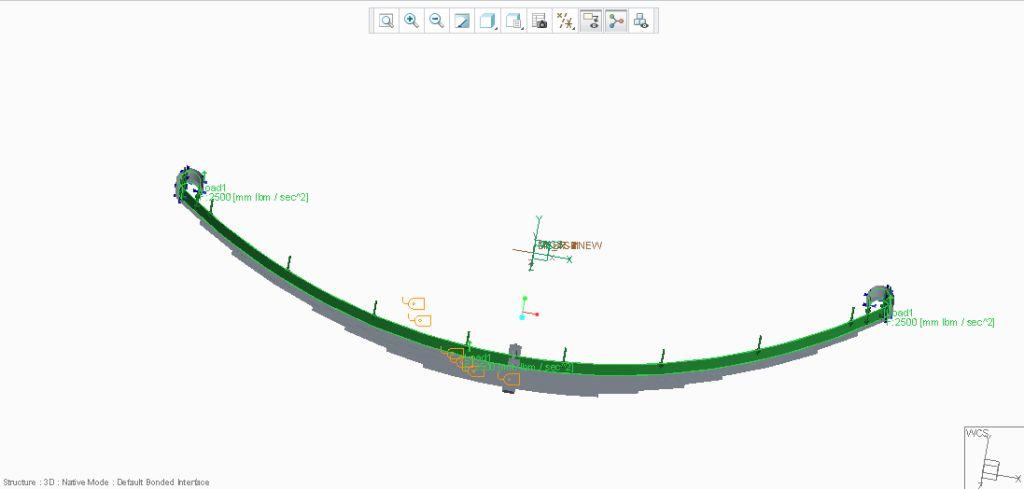
FIGURE 4.4 Load
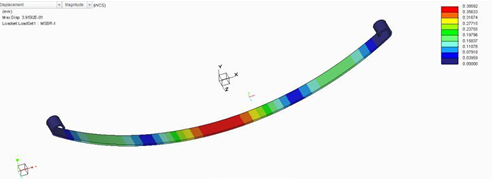
FIGURE 4.5 Displacement
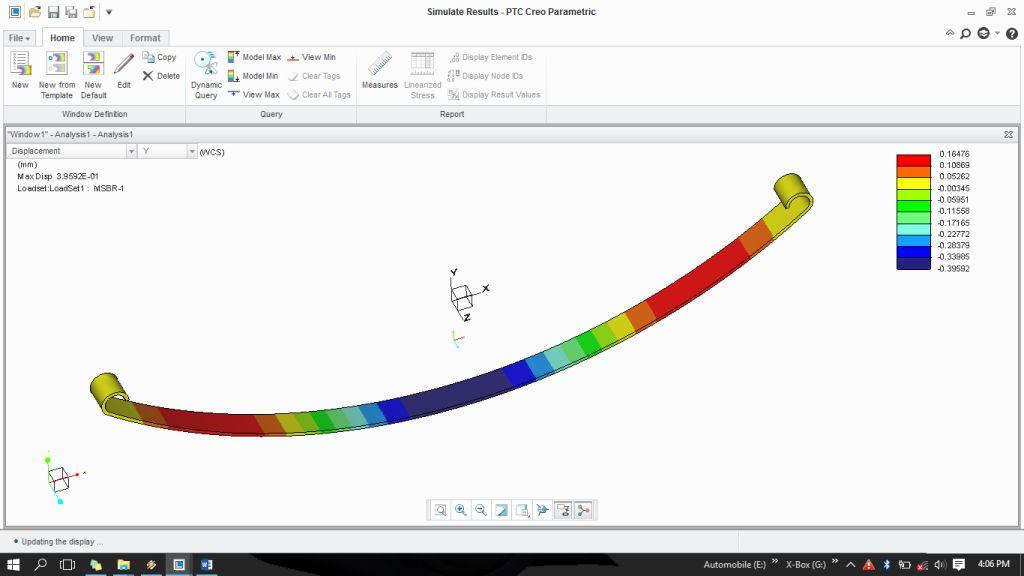
FIGURE 4.6 Displacements AT Y
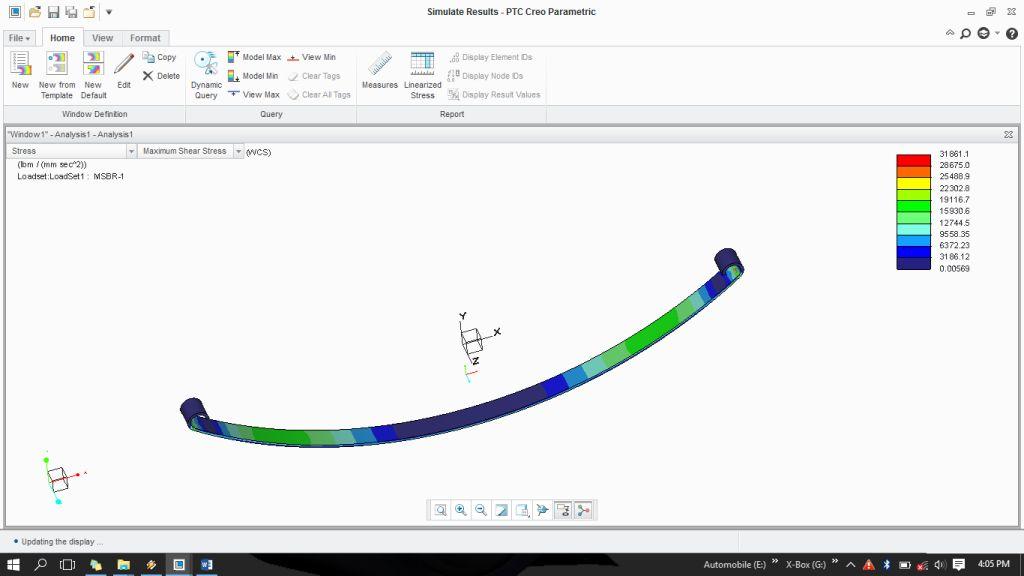
FIGURE 4.7 Max. Shear stress
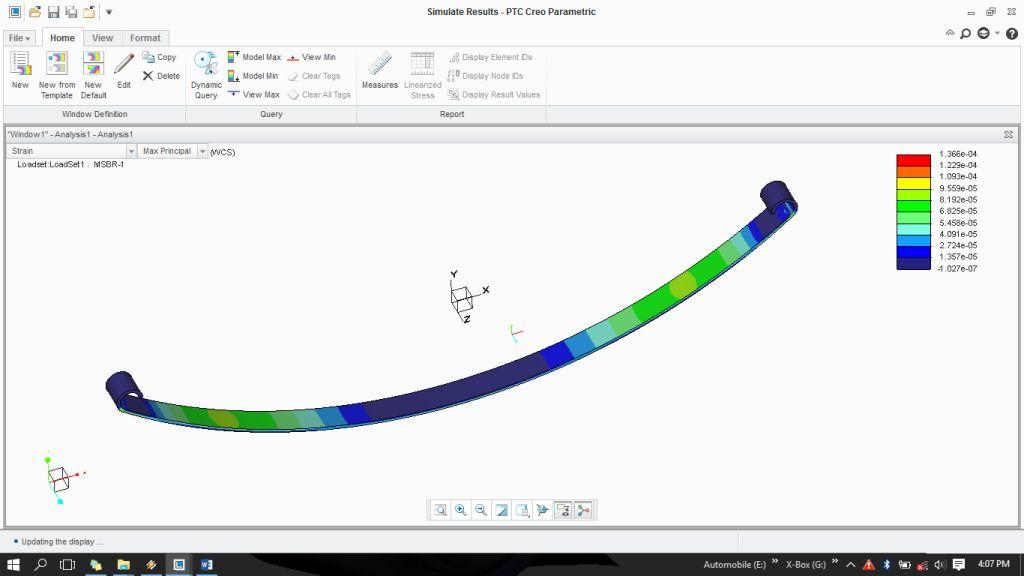
FIGURE 4.8 Strain
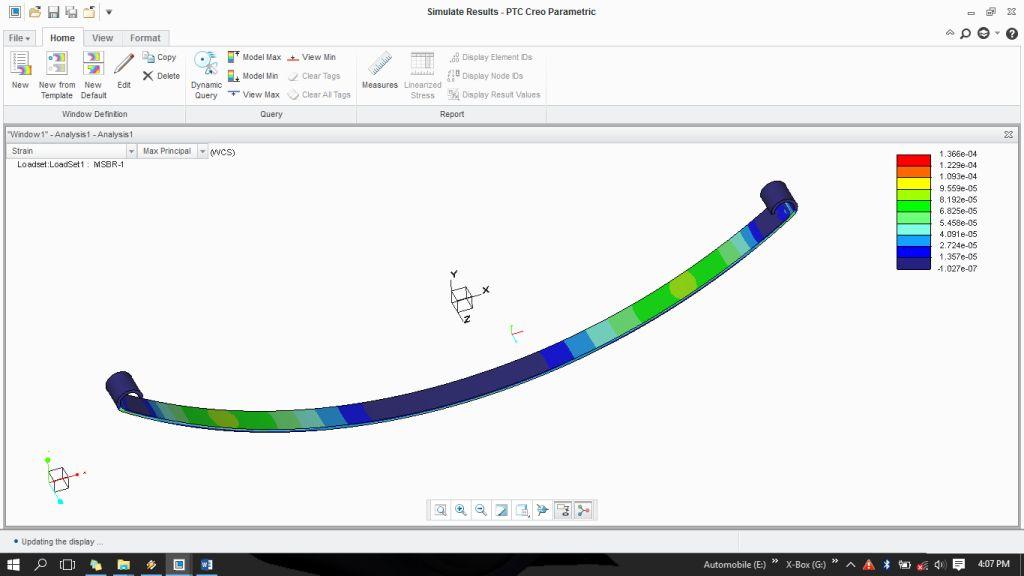
FIGURE 4.8 Strain
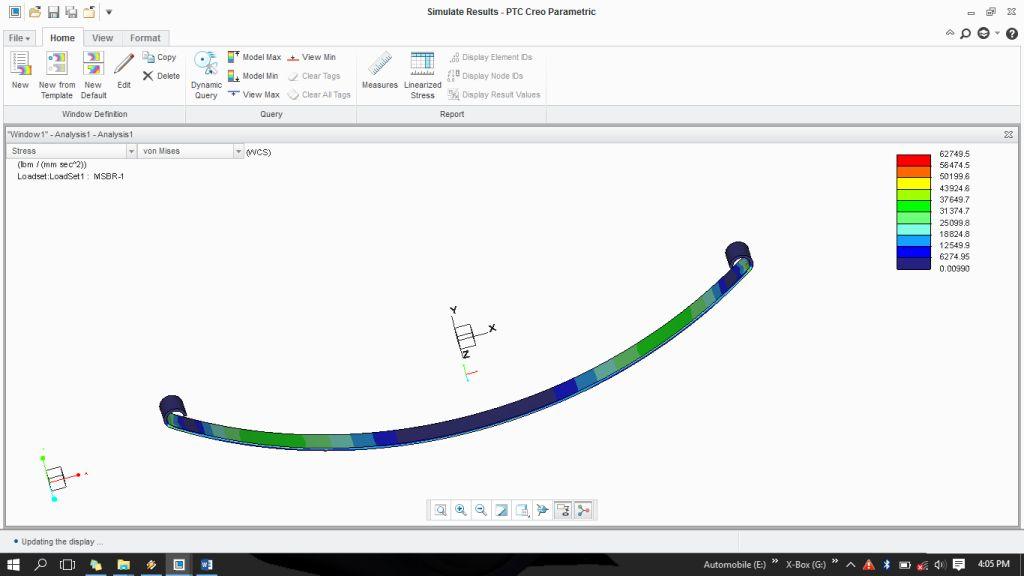
Figure 4.9 Stress Von Mises
D. Result
|
Object Name |
Displacement |
Equivalent Elastic Strain |
Equivalent Stress |
|
Minimum |
-1.027e-07 mm/mm |
|
|
|
Maximum |
3.9592e-01 |
1.366e-04 mm/mm |
62749.5 lbm/mm sec^2 |
Table. 4.4 Static Structural >Results
E. Analysis Using Ansys
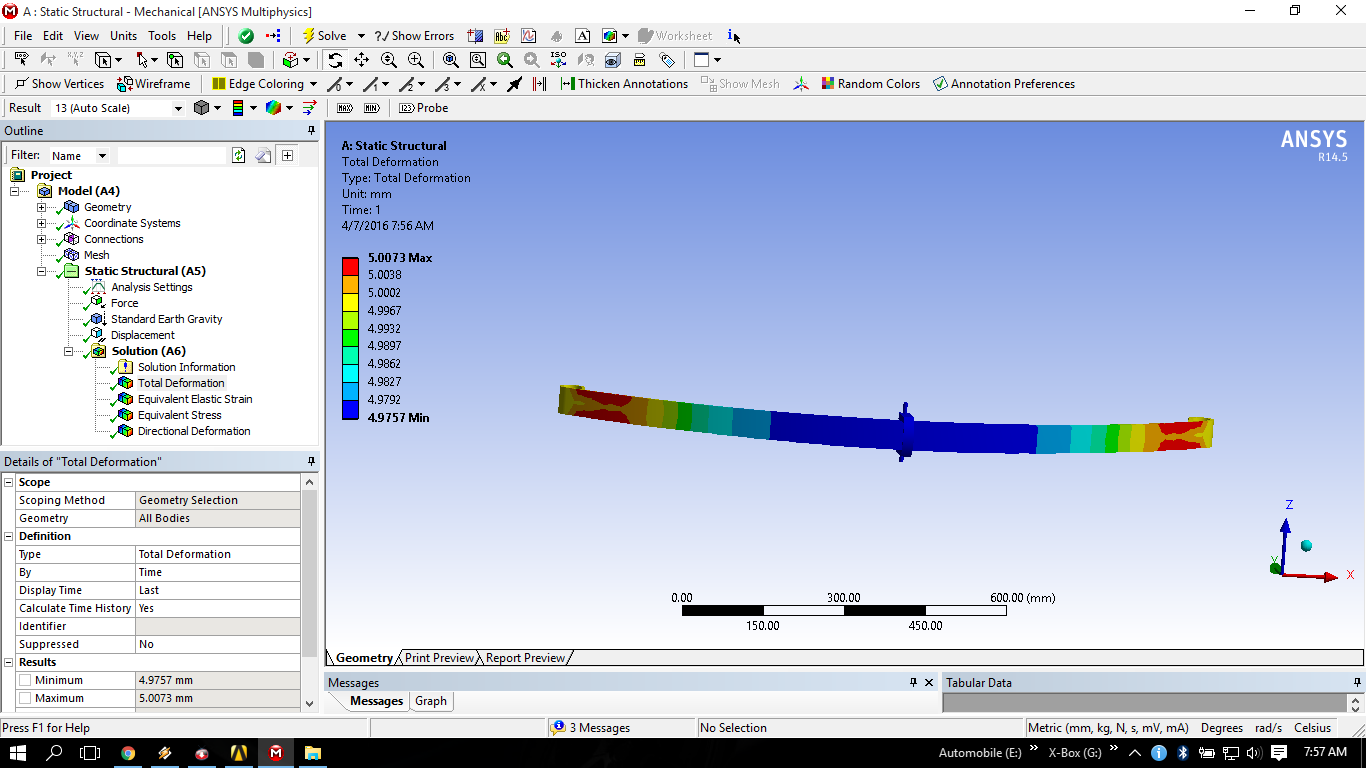
F. Material Is Steel
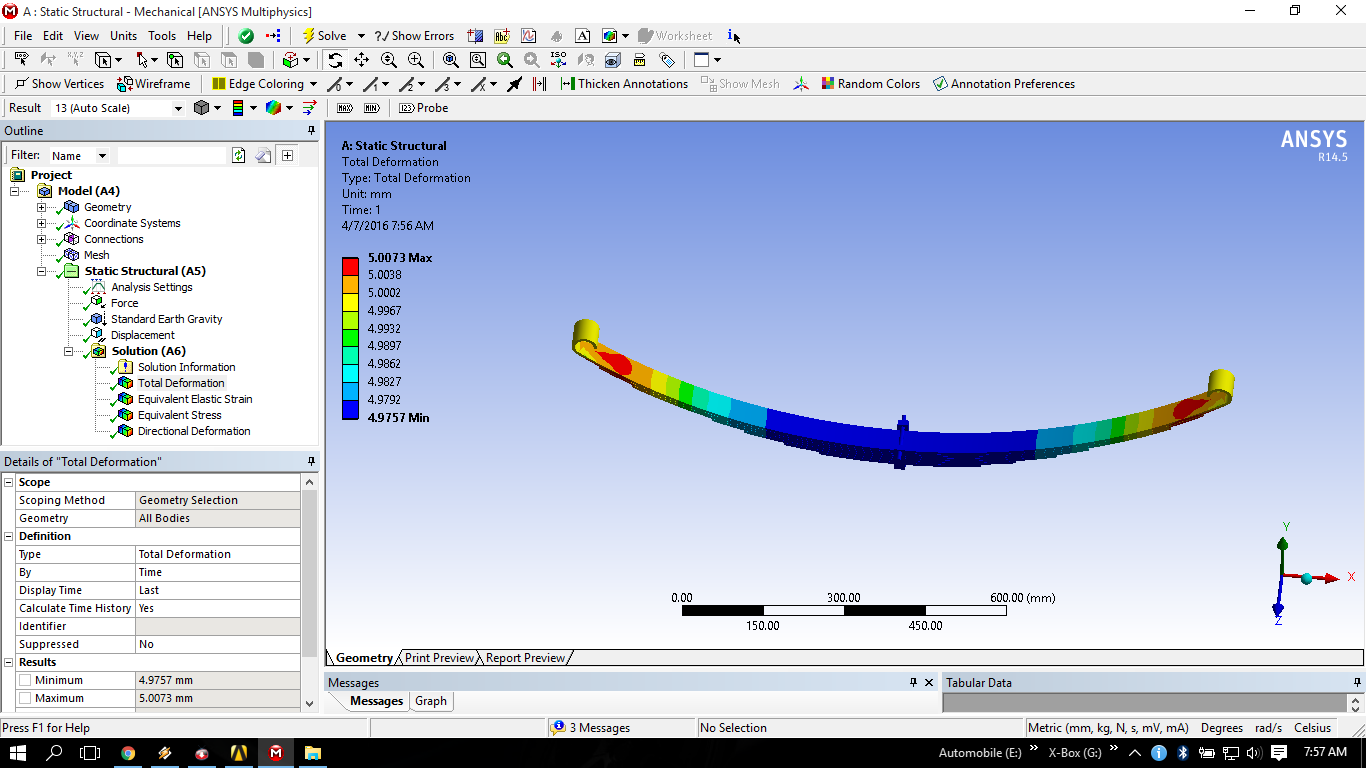
Figure 4.10 Total Deformation
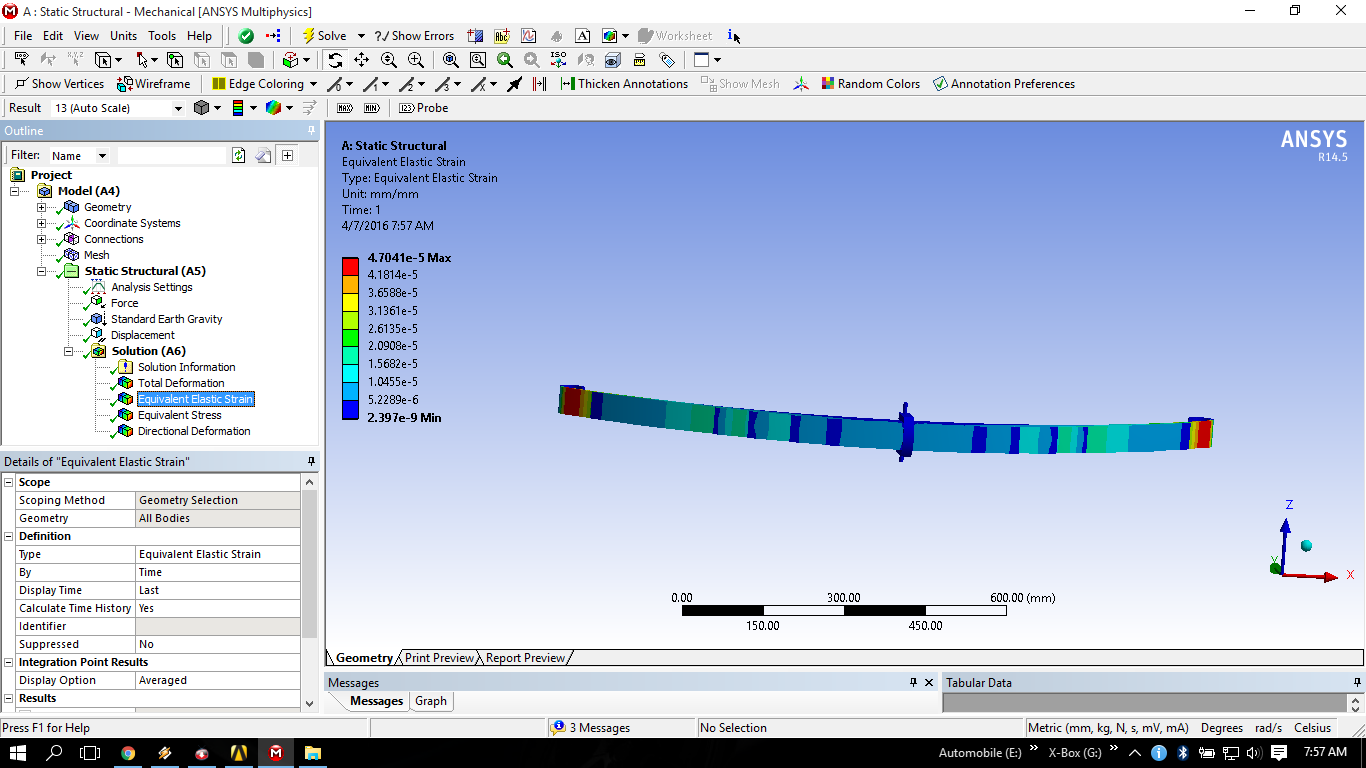
 Figure 4.11 Equivalent Elastic Strain
Figure 4.11 Equivalent Elastic Strain
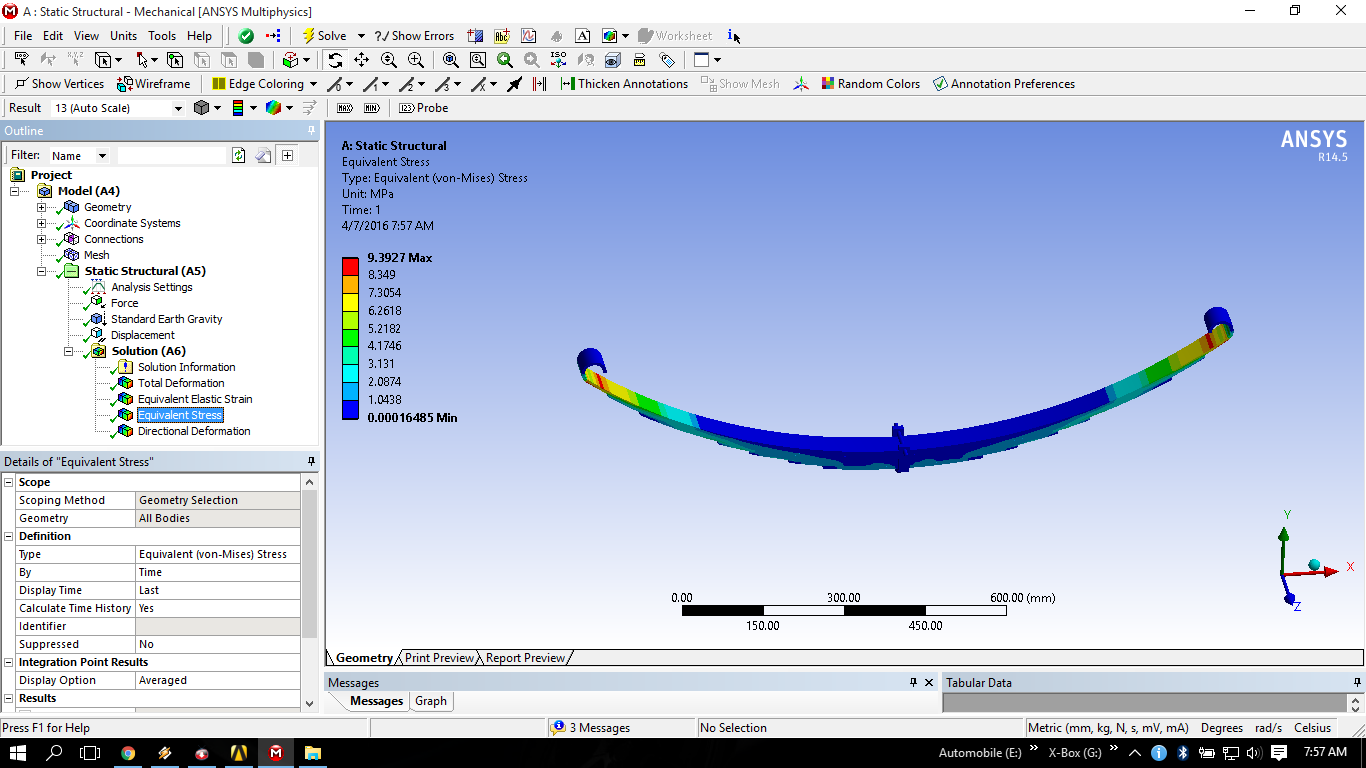
 Figure 4.12 Equivalent Stress
Figure 4.12 Equivalent Stress
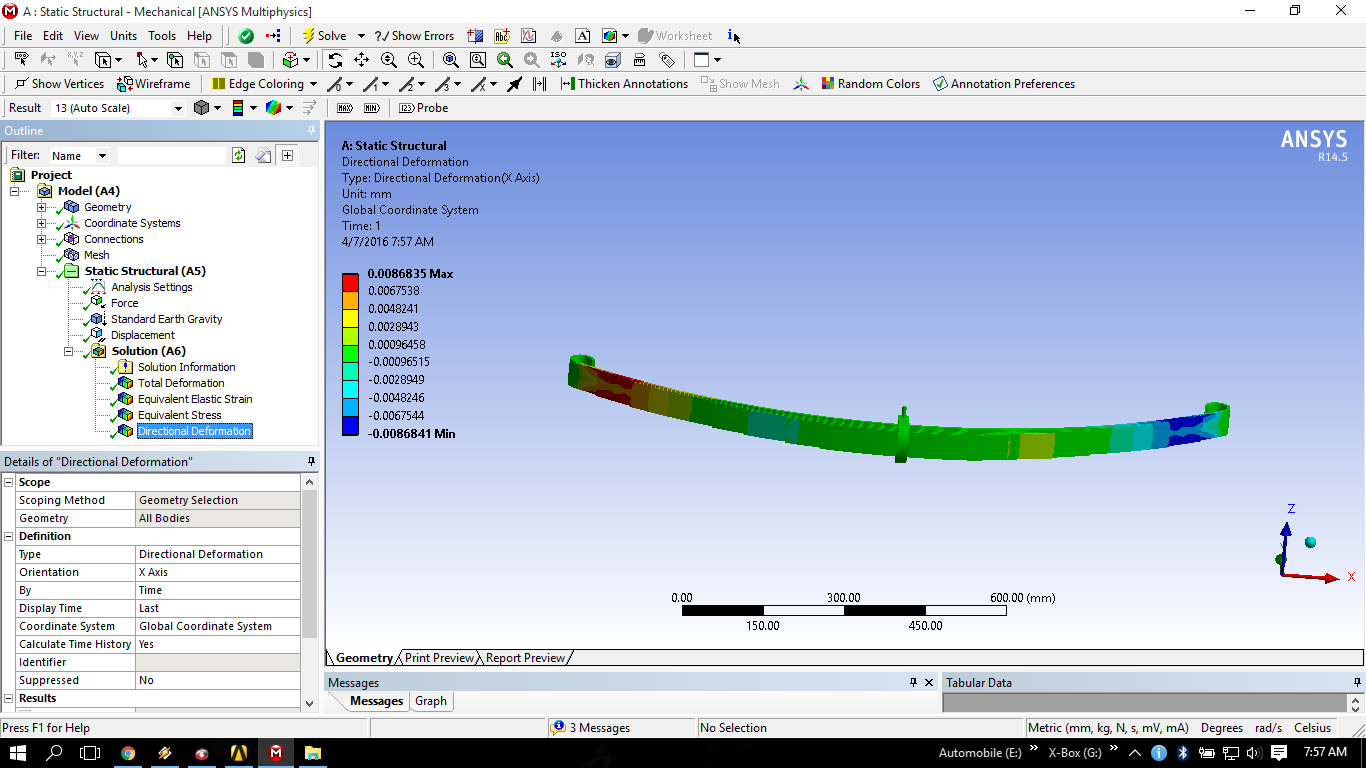
 Figure 4.13 Deformation
Figure 4.13 Deformation
G. Material Details
Table. 4.5 Stainless Steel > Constants
|
Density |
7.75e-006 kg mm^-3 |
|
Coefficient of Thermal Expansion |
1.7e-005 C^-1 |
|
Specific Heat |
4.8e+005 mJ kg^-1 C^-1 |
|
Thermal Conductivity |
1.51e-002 W mm^-1 C^-1 |
|
Resistivity |
7.7e-004 ohm mm |
TABLE. 4.6 STAINLESS STEEL > COMPRESSIVE YIELD STRENGTH
|
Compressive Yield Strength MPa |
|
207 |
TABLE. 4.7 STAINLESS STEEL > TENSILE YIELD STRENGTH
|
Tensile Yield Strength MPa |
|
207 |
TABLE. 4.8 STAINLESS STEEL > TENSILE ULTIMATE STRENGTH
|
Tensile Ultimate Strength MPa |
|
586 |
TABLE. 4.9 STAINLESS STEEL > ISOTROPIC ELASTICITY
|
Young's Modulus MPa |
Poisson's Ratio |
Bulk Modulus MPa |
Shear Modulus MPa |
|
1.93e+005 |
0.31 |
1.693e+005 |
73664 |
H. Loads On Leaf
TABLE 4.10 STATIC STRUCTURAL > LOADS
|
Object Name |
Force |
|
State |
Fully Defined |
|
Scope |
|
|
Scoping Method |
Geometry Selection |
|
Geometry |
1 Face |
|
Definition |
|
|
Type |
Force |
|
Define By |
Vector |
|
Magnitude |
2500. N (ramped) |
|
Direction |
Defined |
|
Suppressed |
No |
I. Solution/Result
TABLE 4.11 MODEL > STATIC STRUCTURAL > SOLUTION > RESULTS
|
Object Name |
||||
|
Minimum |
4.9749 mm |
2.5162e-009 mm/mm |
1.6125e-004 MPa |
-8.9841e-003 mm |
|
Maximum |
5.0075 mm |
4.8718e-005 mm/mm |
9.3856 MPa |
8.9844e-003 mm |
J. Analysis using Composite Material “E-Glass/Epoxy”
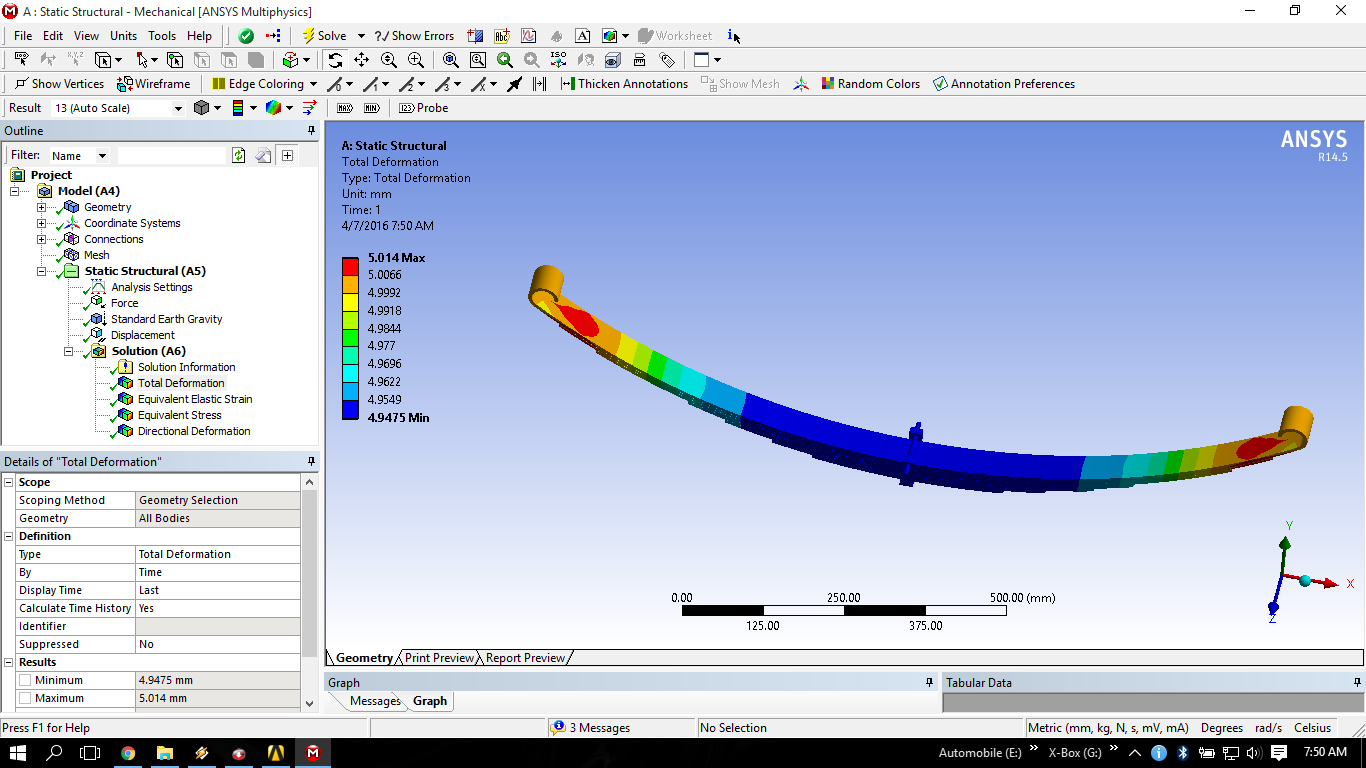
 Figure 4.14 Total Deformation
Figure 4.14 Total Deformation
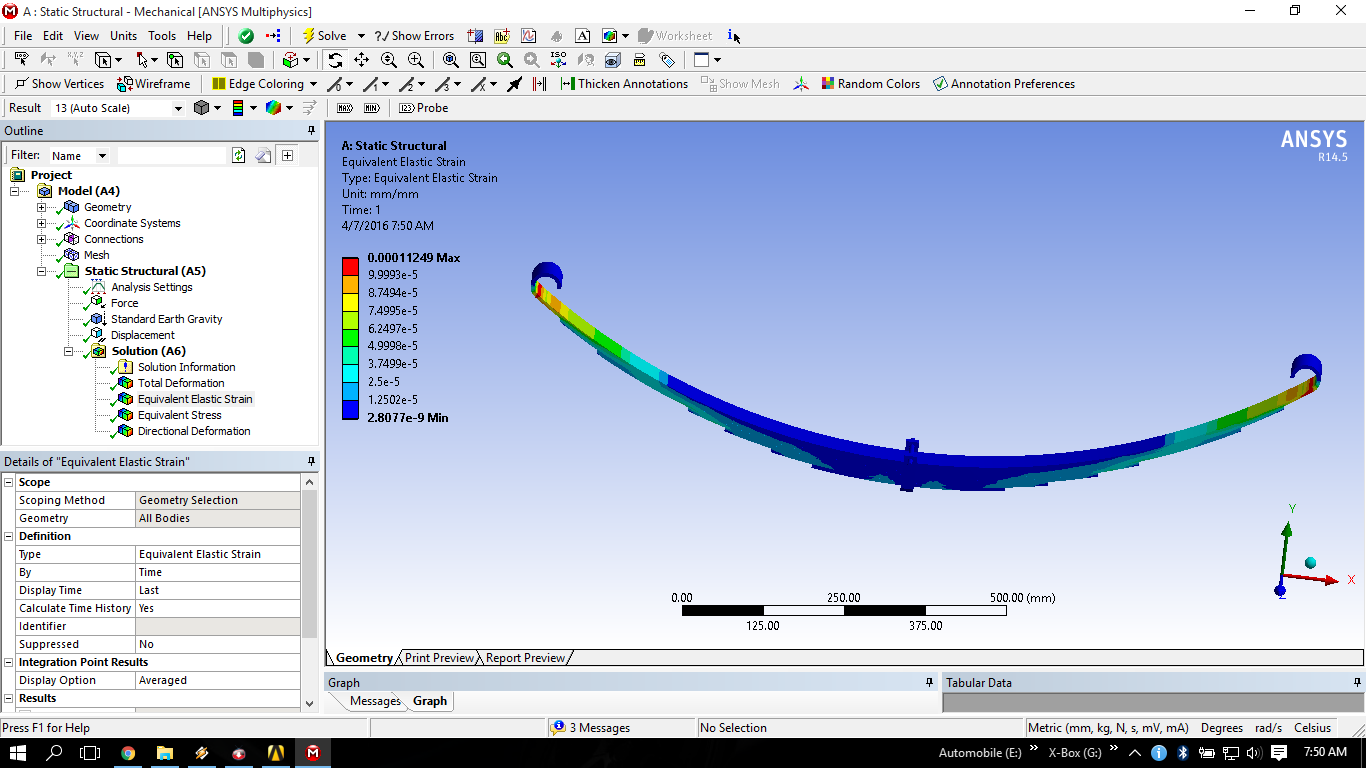
 Figure 4.15 Equivalent Elastic Strain
Figure 4.15 Equivalent Elastic Strain
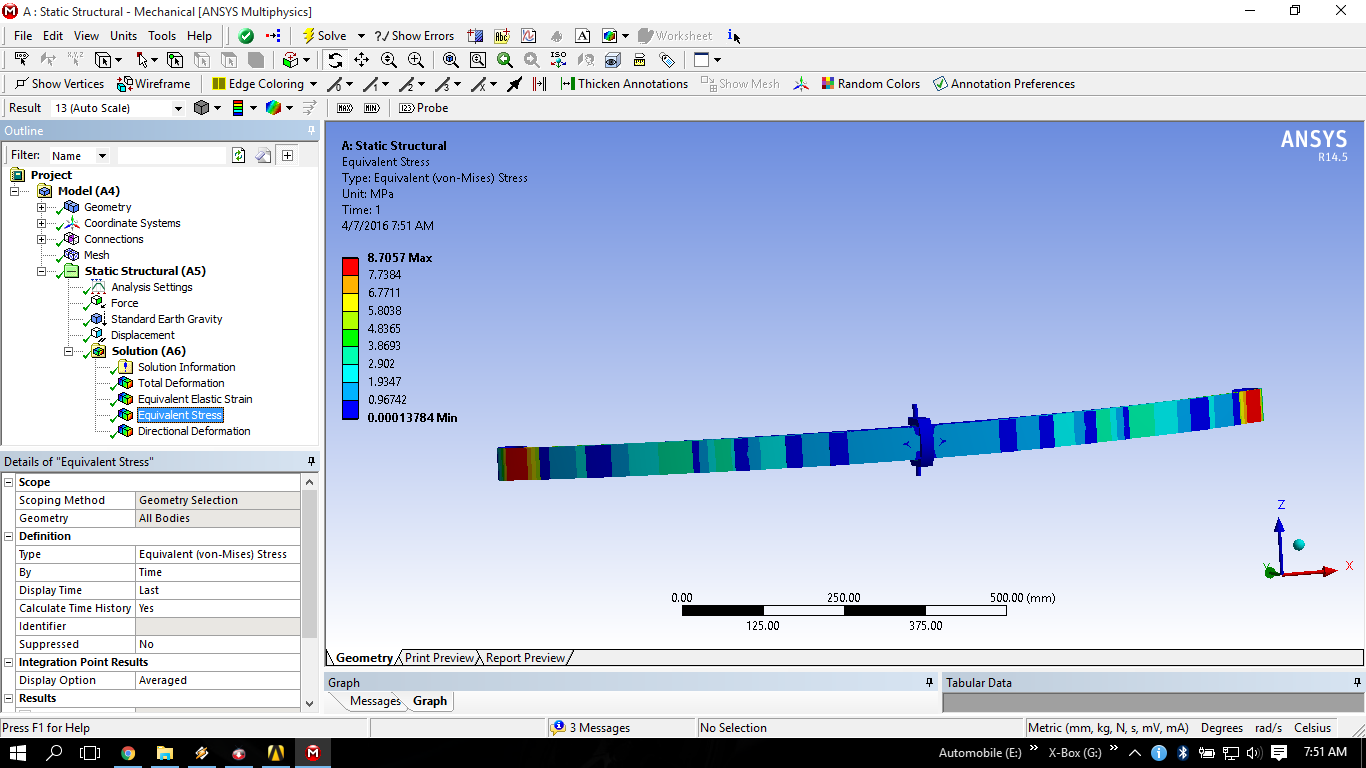
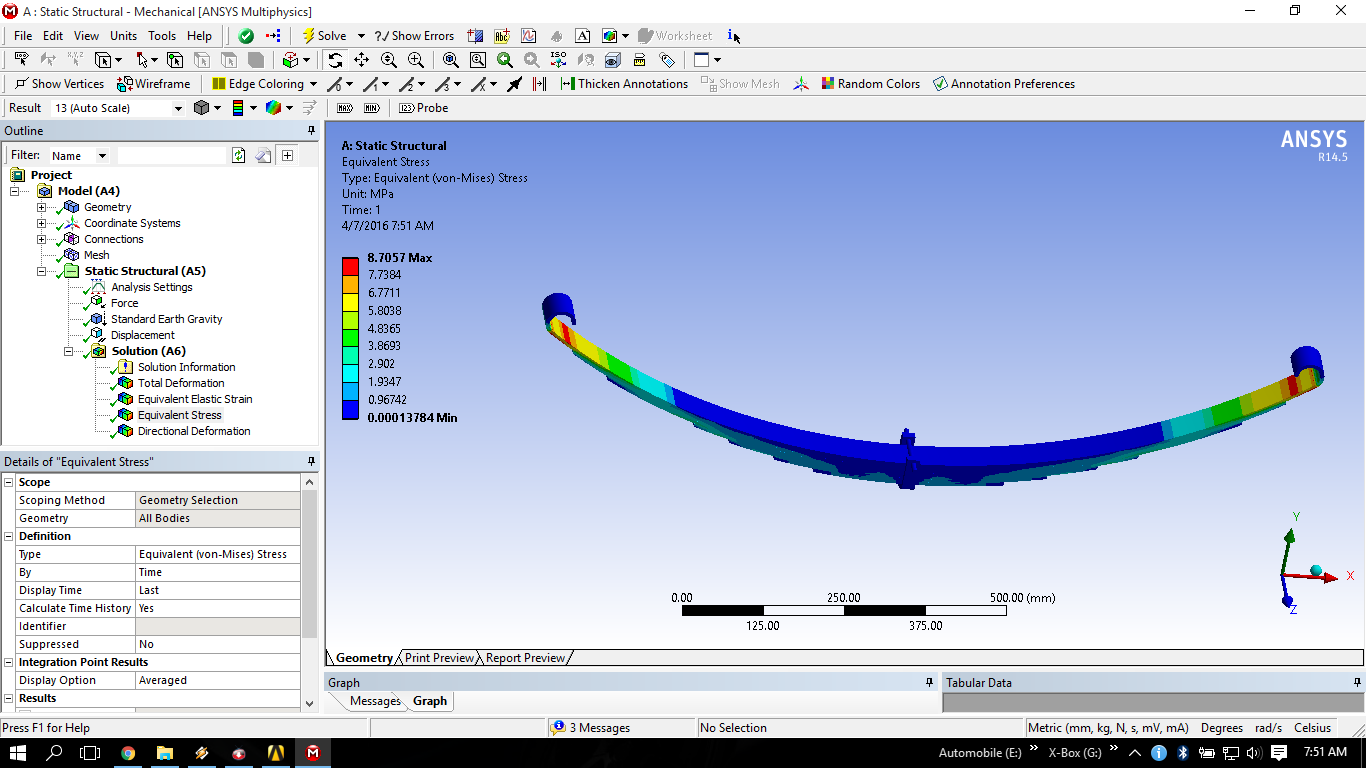
Figure 4.16 Equivalent Stress
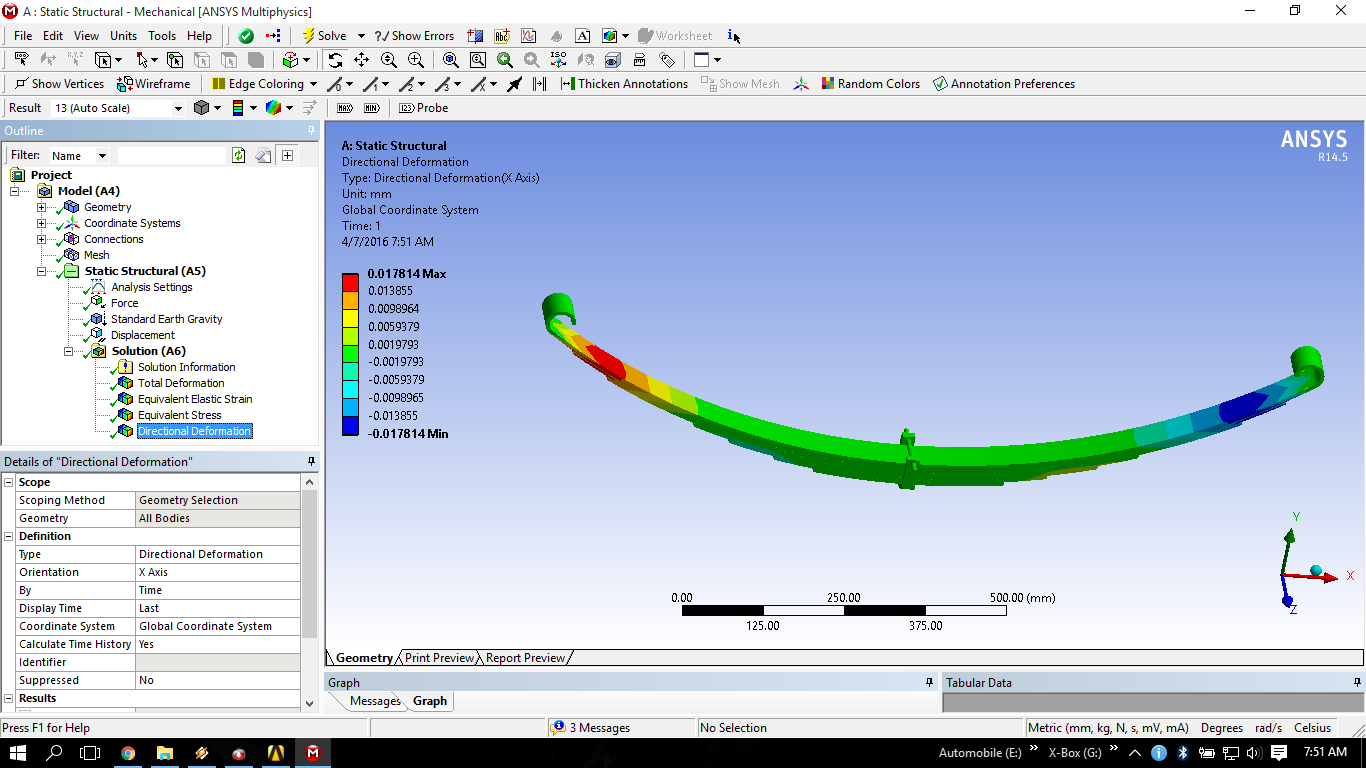
 Figure 4.17 Deformation
Figure 4.17 Deformation
K. Material Data
TABLE. 4.12 E-GLASS/EPOXY> CONSTANTS
|
Density |
2.6e-006 kg mm^-3 |
TABLE. 4.13 E-GLASS/EPOXY> ISOTROPIC ELASTICITY
|
Temperature C |
Young's Modulus MPa |
Poisson's Ratio |
Bulk Modulus MPa |
Shear Modulus MPa |
|
85000 |
0.23 |
52469 |
34553 |
TABLE. 4.14 E-GLASS/EPOXY> TENSILE YIELD STRENGTH
|
Tensile Yield Strength MPa |
|
2050 |
TABLE. 4.15 E-GLASS/EPOXY> COMPRESSIVE YIELD STRENGTH
|
Compressive Yield Strength MPa |
|
5000 |
Load is acting 2500N on leaf spring.
L. Solution/Results
TABLE. 4.16 MODEL > STATIC STRUCTURAL > SOLUTION > RESULTS
|
Object Name |
Total Deformation |
Equivalent Elastic Strain |
Equivalent Stress |
Directional Deformation |
|
Minimum |
4.9477 mm |
2.5584e-009 mm/mm |
7.067e-005 MPa |
-1.7705e-002 mm |
|
Maximum |
5.0139 mm |
1.125e-004 mm/mm |
8.6738 MPa |
1.7705e-002 mm |
Conclusion
Design & Analysis of both steel and E-glass/ Epoxy composite material is done in two different software. Design of leaf spring is done in Creo 3.0 and analysis using Ansys 14 & in Creo 3.0. It observe that steel leaf springs are approximate 80% heavier as compare to composite springs. A comparative study on both analysis & focusing on its equivalent Strain, von- mises Stress and its total deformation we get the results that composite spring is lighter and more economical as compare to steel spring on a same design. The biggest benefit, is mass reduction, Composite leaf springs are up to 5 times more durable than a conventional steel spring. A. Future Scope & Benefits 1) Automobile industries research on reducing weight and increasing strength of products, so they were using such type of spring. 2) By design, leaf springs absorb vertical vibrations caused by irregularities in the road. 3) Weight saving as compare to Aluminium, Steel leaf springs. 4) Internal damping in the composite material leads to better vibration energy absorption within the material, resulting in reduced transmission of vibration noise to neighbouring structures.
References
[1] Gulur Siddaramanna Shiva Shankar, Sambagam Vijayarangan, “Mono composite leaf spring for light weight vehicle, Design, End joint analysis and Testing” ISSN: 1392-1320 Materials science, vol.12, Issue 3-2006,pp-220-225 [2] Shishay Amare Gebremeskel “Design, Simulation, and Prototyping of Single Composite Leaf Spring for Light Weight Vehicle” Global Journal of Researches in Engineering Mechanical and Mechanics Engineering Volume 12 Issue 7 Version 1.0 Year 2012 Type: Double Blind Peer Reviewed International Research Journal Publisher: Global Journals Inc. (USA) Online ISSN: 2249-4596 Print ISSN:0975-5861 [3] Ashish V. Amrute1, Edward Nikhil2,R K Rathore “Design And Assesment of Multi Leaf Spring” ISSN (Online): 2321-3051 International Journal Of Research In Aeronautical And Mechanical Engineering [4] M. Venkatesan, D. Helmen Devaraj, “Design And Analysis Of Composite Leaf Spring In Light Vehicle”. International Journal of Modern Engineering Research (IJMER) ISSN: 2249-6645 Vol.2, Issue.1, Jan-Feb 2012 pp-213-218 [5] Ghodake A. P., Patil K.N. “Analysis of Steel and Composite Leaf Spring for Vehicle” IOSR Journal of Mechanical and Civil Engineering (IOSR-JMCE) e-ISSN: 2278 1684 Volume 5, Issue 4 (Jan. - Feb. 2013), PP 68-76. [4] M. Venkatesan, D. Helmen Devaraj, “Design And Analysis Of Composite Leaf Spring In Light Vehicle”. International Journal of Modern Engineering Research (IJMER) ISSN: 2249-6645 Vol.2, Issue.1, Jan-Feb 2012 pp-213-218 [5] Ghodake A. P., Patil K.N. “Analysis of Steel and Composite Leaf Spring for Vehicle” IOSR Journal of Mechanical and Civil Engineering (IOSR-JMCE) e-ISSN: 2278 1684 Volume 5, Issue 4 (Jan. - Feb. 2013), PP 68-76. [5] Ghodake A. P., Patil K.N. “Analysis of Steel and Composite Leaf Spring for Vehicle” IOSR Journal of Mechanical and Civil Engineering (IOSR-JMCE) e-ISSN: 2278 1684 Volume 5, Issue 4 (Jan. - Feb. 2013), PP 68-76. [6] Mahmood M. Shokrieh *, Davood BOOKS [1] Heinz Heisler, Advanced Vehicle Technology, London U.K. [2] Dr.Kripal Singh, Automobile Engineering Vol. 1, Delhi India [3] Richard Stone and Jeffrey K. Ball, Automotive Engineering Fundamentals, SAE International, Warrendale, Pa USA
Copyright
Copyright © 2024 Ramsingar Singh, Dr. H. S. Chandra . This is an open access article distributed under the Creative Commons Attribution License, which permits unrestricted use, distribution, and reproduction in any medium, provided the original work is properly cited.

Download Paper
Paper Id : IJRASET64073
Publish Date : 2024-08-24
ISSN : 2321-9653
Publisher Name : IJRASET
DOI Link : Click Here
 Submit Paper Online
Submit Paper Online

